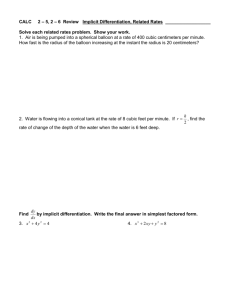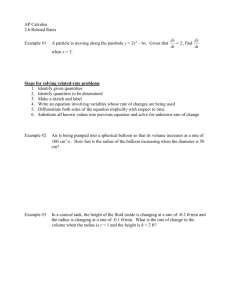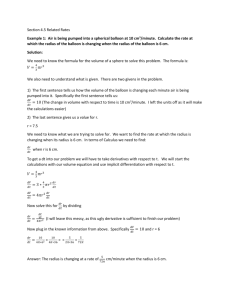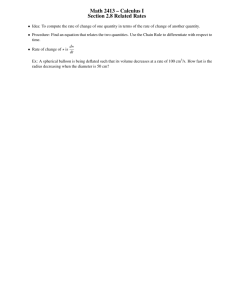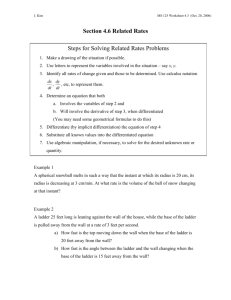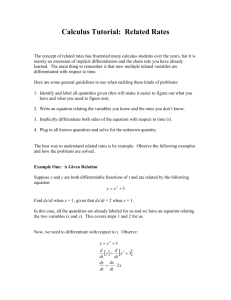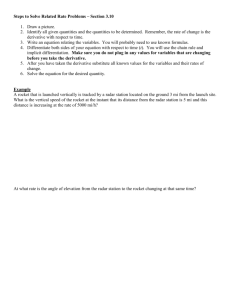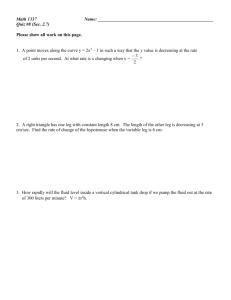What are related rates? And why should I care?
advertisement
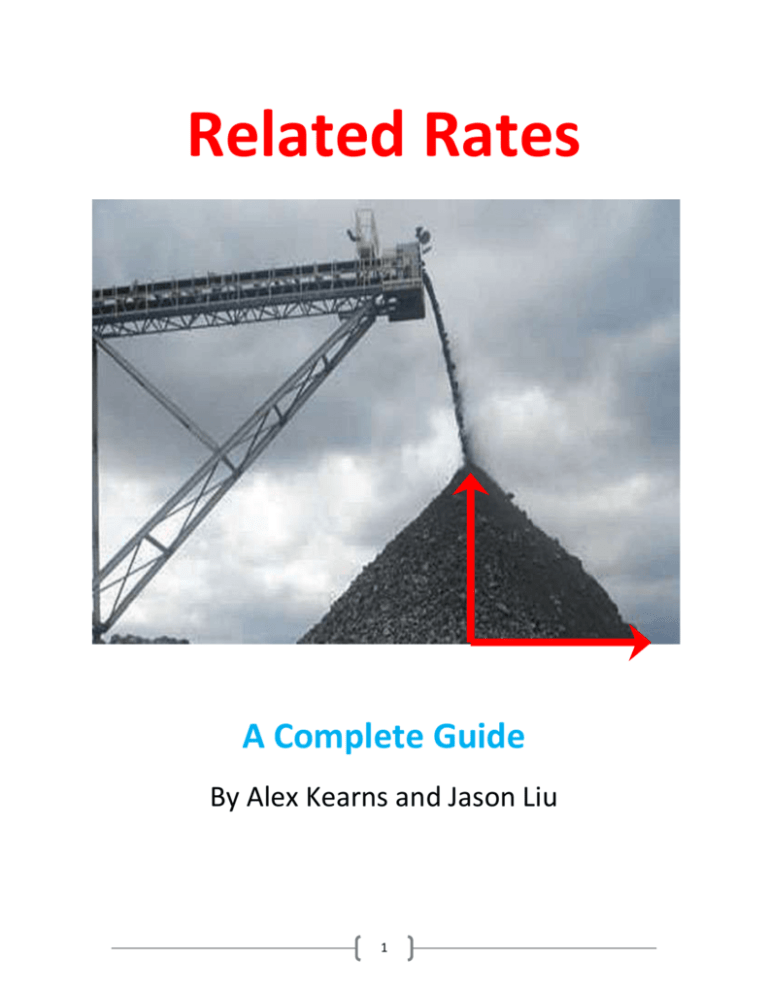
Related Rates A Complete Guide By Alex Kearns and Jason Liu 1 Table of Contents What are Related Rates? And Why Should I Care? .............................................................................. 3 Who Could Possibly Have Developed Related Rates? .......................................................................... 4 Just Tell Me How To Do Them Already!............................................................................................... 5 Examples ........................................................................................................................................... 7 Example 1 (Analytical)............................................................................................................................... 7 Example 2 (Multiple Choice) ..................................................................................................................... 8 Example 3 (Conceptual) .......................................................................................................................... 10 Example 4 (Graphing).............................................................................................................................. 11 Example 5 (Free Response) ..................................................................................................................... 14 Exercises .......................................................................................................................................... 16 Analytical Exercises ................................................................................................................................. 16 Multiple Choice Exercises ....................................................................................................................... 18 Free Response Exercise ........................................................................................................................... 20 Sources ............................................................................................................................................ 21 Exercise Solutions ............................................................................................................................ 22 2 What are related rates? And why should I care? Often times in life, things don’t just change independently: for example, the rate at which a piece of food is digested might not be constant, but might depend on the surface area of the food, the amount of food left, or the concentration of the acid. The physics equations for constant acceleration kinematics, the so-called “Big Five”, are based on the relationship between acceleration, velocity, position, and time. If water is pouring out of a cone, the water level decreases with respect to the volume of water still in the cone. In all these situations, we need a way to find out how different quantities are related to each other, and this is exactly what related rates do. They take all the formulas that we learned in geometry and algebra and apply them to real life, where things are not constant, but always changing. In this way, related rates are a very useful tool for many real life situations, and aren’t just some useless formula that you’ll never use after this class. Related rates are everywhere. There are many places where related rates are present in the real world. Essentially whenever two things are moving and when one’s motion is based on the other, related rates are at work. Besides the examples above, related rates are in almost every imaginable situation where something is moving. When someone’s shadow is moving, that’s a related rate; when a pile of grain is getting bigger that’s a related rate; even the viewing angle of an airplane flying overhead can involve related rates, or an enzyme reacting with a compound, a ladder falling from a house, the bus you used to get here… you get the idea. They’re basically used in all scientific disciplines where things change with respect to time: physics, chemistry, biology, engineering, as well as studies in less calculusbased topics such as economics where things change with respect to time. In other words, if you choose any field that is remotely mathematical, you will probably encounter related rates at some point. So who came up with this great idea that is so prevalent today? 3 Who Could Possibly Have Developed Related Rates? Actually, there is no single person that can be pointed to who can be universally credited with having “created” related rates. However, there are notable people who can be said to have contributed to the topic of related rates. One of these people was… William Ritchie!!!! (Sorry, there is no picture of this particular William Ritchie. He did not want to have his picture taken on request. We apologize for any inconvenience this may have caused.) Born 1790, Died 1837. (In case you were wondering, people didn’t live long back then, and he died before he could hear of the success of his work, as the writing was only published a year before his death.) Ok, so what did he really contribute to related rates? He is actually credited with having created the first known related rates problems, which date back all the way to 1836. Ritchie was also one of the first people to voice and attempt to address the issue of the practical application of Calculus to real life issues. In fact, he used related rates to make Calculus seem usable in real life. In his work Principles of the Differential and Integral Calculus, Ritchie went through the simple fundamentals of Calculus, and in his problems, often required related rates to be applied. Ritchie’s application of related rates to the understanding of calculus is what makes him central to this topic. In interesting note: Ritchie was not from a mathematical family, and he was actually a physicist, not a mathematician. So, even though related rates deals with Calculus, this topic addresses a far more broad range of issues. * Mathematics Magazine – retrieved from http://www.maa.org/pubs/Calc_articles/ma009.pdf 4 Just tell me how to do them already!* Alright, alright! Related rates problems really aren’t as hard as they might at first seem. In order to solve related rates problems, you’ll need some common sense and ingenuity depending on the situation since there are so many places that related rates can be used. Usually, you have one rate and some other quantities, and you’ll need to find another rate. Now, before you hurt yourself trying to figure it out, remember what taking a derivative does: it tells you the rate at which a quantity is changing. So, if you have an equation relating two quantities, and you take the derivative (using implicit differentiation), you’ll end up with an expression relating the rates of the two quantities. Then all you need to do is plug and chug. It looks kind of like this: Since you don’t directly know the relationship between the rates, you need to work around it using the actual quantities. Then you can find the relation between the rates. After that, it’s pretty clear cut. The hard part is finding the right equation to use. In general, there are several steps that you’ll always need to do to be successful: Step 1: Find an equation, or equations, that relate the quantities that you are given and the quantities that you need. For example, if you need to find the rate that a circle’s area is increasing and you’re given its radius, you know that 𝐴 = 𝜋𝑟 2 . 5 Step 2: Differentiate implicitly to find rates with respect to time. All this means is take the derivative of both sides of the equation, and for each variable (A and 𝑟 in this case), take the derivative like you normally would and add a 𝑑𝑞 𝑑𝑡 , where q is the quantity (you need to do this because of the Chain Rule). You might need to use the product or quotient rules, etc., if there are multiple variables. 𝑑𝐴 𝑑𝑟 For our example, 𝐴 𝑑𝑡 = 2 𝜋 𝑑𝑡 . 𝑑𝑞 Step 3: This is the easy part. Just solve for the quantity that you need. The 𝑑𝑡 term is the rate that q is changing. For any quantities that you don’t have yet, use your original equation to find it. That’s it! Not too hard, is it? That’s all there is to it! Now, let’s see if you’ve got the hang of it. There are some examples on the next page. Try to do them yourselves first. If you get stuck, look at the solution for a hint. Regardless of whether you get them right or not, take a look at the explanation to see the thinking behind them. *Wikipedia.org—Related Rates 6 Examples (you knew they were coming) Example 1 (Analytical) If the two legs of a triangle are expanding at a rate of 3m/s and 4m/s and have lengths of 2m and 5m, respectively, at what rate is the hypotenuse expanding? Solution 𝑐 𝑑𝑎 = 3 𝑚/𝑠 𝑑𝑡 𝑑𝑐 𝑑𝑡 𝑎 = 5𝑚 𝑑𝑏 = 4 𝑚/𝑠 𝑑𝑡 𝑏 = 12 𝑚 First, use the Pythagorean Theorem to express the relationship between the sides: 𝑎2 + 𝑏 2 = 𝑐 2 Next, differentiate implicitly: take the derivative of the three variables with respect to time (this will let you relate the rates of the variables with respect to each other: hence the name, related rates). 2𝑎 𝑑𝑎 𝑑𝑏 𝑑𝑐 + 2𝑏 = 2𝑐 𝑑𝑡 𝑑𝑡 𝑑𝑡 𝑑𝑎 𝑑𝑏 𝑑𝑐 +𝑏 =𝑐 𝑑𝑡 𝑑𝑡 𝑑𝑡 𝑑𝑎 𝑑𝑏 𝑑𝑐 Uh oh! We have 𝑎 and 𝑏 as well as 𝑑𝑡 and 𝑑𝑡 , but we still need 𝑐 to solve for 𝑑𝑡 . 𝑎 Remember the Pythagorean Theorem that we used in the beginning? We’ll use it again here. Just solve for 9𝑐. 𝑐 = √𝑎2 + 𝑏 2 = √52 + 122 = 13 Solve for 𝑑𝑐 , 𝑑𝑡 plug the numbers in, and voila! You’re done. 3𝑚 4𝑚 𝑑𝑎 𝑑𝑏 𝑑𝑐 𝑎 𝑑𝑡 + 𝑏 𝑑𝑡 (5𝑚) ( 𝑠 ) + (12𝑚)( 𝑠 ) = = 𝑑𝑡 𝑐 13𝑚 𝑑𝑐 63 = 𝑚/𝑠 𝑑𝑡 13 7 Example 2 (Multiple Choice) A 13 foot long ladder is sliding down and away from a wall at a rate of 10 feet per second. If the rate at which the top part of the ladder is falling to the ground is 6 feet per second, how fast is the bottom part of the ladder sliding away from the wall when the distance between the top part of the ladder and the ground is 5 feet? A) π B) 7 3 C) 90 13 D) E) 1120 25 3 8 Solution You know the rate of change for that of the ladder and that of the top part to the ground. You also know two of the three sides. Since the ladder, wall, and ground make a right triangle, the Pythagorean Theorem can be applied here to find the unknown third distance (that between the wall and the lower part of the ladder). Let A be the length between the wall and the bottom part of the ladder, B be the length between the ground and the top part, and C be the overall ladder length: A2+B2=C2 A2+52=132 A=√ (169-25) =√144=12 feet. Now that you know all of the lengths, we can differentiate the same equation: A2+B2=C2 2A dA dB dC +2B =2C dt dt dt Knowing that A=12, B=5, 2(12) dB dA dC =6, C=13, and =10, you can now solve for : dt dt dt dA +2(5)(6)= 2(13)(10) dt dA 2(13)(10) 2(5)(6) = dt 2(12) dA 25 = dt 3 Therefore, the answer is E. A is blatantly incorrect, for there is no relation of circles in this question whatsoever. B is incorrect because dB dC =6 and =10, not the other way around. dt dt C is incorrect because A=12 and C=13, not the other way around either. D is incorrect because the derivative was taken incorrectly. 2A 2 correct derivative, not A2 dA 2 2 dB 2 2 dC +B =C . dt dt dt 9 dA dB dC +2B =2C should be the dt dt dt Example 3 (Conceptual) A fire begins in a field and burns outward in a circle in all directions. Firefighters measure the progress of the blaze by measuring its distance from the source at different times along with the rate its circumference is increasing. If the radius increases at a constant rate, find a formula that allows the firefighters to find the rate the area affected by the blaze is increasing with respect to the rate the circumference is increasing and the radius of the circle. First, we need a formula relating the area of a circle to its radius. If you remember anything from geometry class, you’ll remember the formula for the area of a circle: 𝐴 = 𝜋𝑟 2 𝑟 That’s a good start, but we need to find a way to relate this to circumference, like the problem asks. Well, let’s take a look at the circumference formula: 𝐶 = 2𝜋𝑟 Notice a similarity? They both have an r! Just solve one for r to eliminate it. 𝑟= 𝐶 2𝜋 𝐶 𝐶2 𝐴 = 𝜋( )2 = 2𝜋 4𝜋 And there we have it! A formula for area with respect to circumference. But remember, we’re looking for a rate. For this, we need implicit differentiation. 𝑑𝐶 𝑑𝐴 2𝐶 𝑑𝑡 = 𝑑𝑡 4𝜋 𝑑𝐶 We want our formula in terms of 𝑑𝑡 and r, so sub back in to get rid of the C and get an r in its place. 𝐶 = 2𝜋𝑟 𝑑𝐶 𝑑𝐴 2(2𝜋𝑟) 𝑑𝑡 𝑑𝐶 = =𝑟 𝑑𝑡 4𝜋 𝑑𝑡 And there we go! Now the firefighters will be able to figure out the information they need! 10 Example 4 (Graphing) A car is heading north toward an intersection at a speed of 45 miles per hour. Meanwhile, another car travels Westbound toward the same intersection at a speed of 60 miles per hour. If, at t=0, the Northbound car is 20 miles from the intersection and the Westbound car is 30 miles from the intersection, when is the distance between the cars increasing? When is it decreasing? 𝑑𝑟 = −45𝑚𝑖/ℎ 𝑑𝑡 𝑟 𝑏 𝑦 𝑑 𝑑𝑏 = 60𝑚𝑖/ℎ 𝑑𝑡 𝑥 While we could do this just numerically, it is much easier to see what is happening if we graph distance with respect to time. For this problem, let’s let the distance between the red Westbound car and the intersection be 𝑟, the blue Northbound car be 𝑏, and the total distance between the cars be 𝑑. First, we’ll use the Pythagorean Theorem to show the relationship between our three quantities: 𝑟 2 + 𝑏2 = 𝑑2 Differentiate implicitly for the related rates equation: 2𝑟 𝑑𝑟 𝑑𝑏 𝑑𝑑 + 2𝑏 = 2𝑑 𝑑𝑡 𝑑𝑡 𝑑𝑡 We’re looking for the rate at which the distance is changing, so solve for that. 𝑑𝑟 𝑑𝑏 𝑑𝑑 𝑟 𝑑𝑡 + 𝑏 𝑑𝑡 = 𝑑𝑡 𝑑 We have a lot of unknown quantities here, so let’s get rid of 𝑑. 𝑑 = √𝑟 2 + 𝑏 2 11 𝑑𝑟 𝑑𝑏 𝑑𝑑 𝑟 𝑑𝑡 + 𝑏 𝑑𝑡 = 𝑑𝑡 √𝑟 2 + 𝑏 2 𝑑𝑟 𝑑𝑏 We know that 𝑑𝑡 and 𝑑𝑡 are constant, so we don’t need to worry about them. However, we don’t know what 𝑟 and 𝑏 are at all times. Wouldn’t it help if we got them with respect to time? Remember that if you multiply a constant speed by a time, you get position. Don’t forget to add the initial condition! Therefore: 𝑟=𝑡 𝑑𝑟 + 30 𝑑𝑡 𝑏=𝑡 𝑑𝑏 − 20 𝑑𝑡 Just sub these in and we’ve got everything we need in our equation! 𝑑𝑟 𝑑𝑟 𝑑𝑏 𝑑𝑏 𝑑𝑑 (𝑡 𝑑𝑡 + 30) 𝑑𝑡 + (𝑡 𝑑𝑡 − 20) 𝑑𝑡 = 𝑑𝑡 √(𝑡 𝑑𝑟 + 30)2 + (𝑡 𝑑𝑏 − 20)2 𝑑𝑡 𝑑𝑡 This is pretty nasty looking, but our graphing calculator can handle it. Just plug in the constants and plug the whole mess into your calculator. 𝑑𝑑 (−45𝑡 + 30)(−45) + (60𝑡 − 20)(60) = 𝑑𝑡 √(−45𝑡 + 30)2 + (60𝑡 − 20)2 http://functiongrapher.com/ 12 𝑑𝑑 You should get a graph like this. We can see that the change from positive to negative occurs in 𝑑𝑡 between t=0 and t=1. Just use the zero function of your calculator to find the exact value. You should get: 𝑡 = 0.4533s We can see that to the left of the zero, the distance between the cars is decreasing with respect to time 𝑑𝑑 𝑑𝑑 since 𝑑𝑡 < 0. To the right of the zero, 𝑑𝑡 > 0 and the distance between the cars is increasing. The final answer is: 𝑑𝑑 𝑑𝑡 is decreasing when 𝑡 < 0.453 s and increasing when 𝑡 > 0.453 s. This makes sense if we think about it: as both cars approach the intersection, they are getting closer together. When one car passes through the intersection, it begins moving away from the other car, but the other car continues getting closer; and finally, when the second car passes through the intersection and begins moving away, both cars are definitively moving away from each other. The distance must change from decreasing to increasing somewhere in the middle interval, when one car is approaching the intersection and the other is moving away. Although we can’t tell where exactly this occurs without crunching the numbers, if you have a general conceptual idea of this concept, you should be in good shape (see Multiple Choice Exercise 1 for a problem like this). 13 Example 5 (Free Response) NOTE: A graphing calculator can be used on this section. 1. A tub in the shape of a cylinder is being filled and emptied of water at the same time, and the duration of this is 0 t 9 . At t=0, there are 500 gallons of water in the tub. The radius of the tub is 15 feet. The rate at which water is filling the tub in cubic gallons per second is given by the equation F(t) =29(t).06+94, while the rate at which water is emptying from the tub in cubic gallons per second is given by the equation E(t) =40(t).17+108. a.) At t=5, what is the rate of change of water in the tub, and is the tub emptying or filling? b.) What is the rate at which the height of the water in the tub relative to the bottom of the tub is changing at t=5? (The equation for the volume of a cylinder is V=πr2h, with r being the radius of the cylindrical tub and h being the height.) 14 Solution: a.) Given the rate at which water is both flowing and emptying out of the tub, you can substitute the variable t for the given number 5 and subtract the value of the water flowing out from the value of the water filling up the tub: R(5)= F(5)-E(5)= 29(5).06+94-40(5).17-108= -34.648 cubic gallons per second b.) Determining the rate at which water is moving in the tub, apply implicit differentiation to the equation for the volume of a cylinder to determine the rate at which the volume of the water is changing: V=πr2h dh dV πr2 dt dt dh -34.648=π(15)2 dt dh 34.648 dt = (15) 2 dh = dt -.049 feet per second Remember, when differentiating both sides, apply the general differential rules to each side by itself! Do not think that there is any fancy new way to differentiate an equation. Treat each side as if it were simply an expression and put the differentiated equations back into the equation. That way, you will not confuse the equation. 15 Exercises Analytical Exercises Answer the following questions based on the information given. Show all work and be sure to include units in your answers. No calculator is allowed unless otherwise stated in the problem. Express answers in simplest fractional form. 1. A 6 foot man is walking away from a light elevated 10 feet off the ground and 8 feet horizontally from his feet. If he walks at 5 m/s, at what rate is his shadow increasing in length? 2. Sand falls from a conveyor belt into a conical pile. If 10 cubic feet of sand are added to the pile every minute and the radius of the cone’s base is twice its height, find the rate at which the height is increasing when the volume of the pile is 20 cubic feet. 3. A particle’s position in the coordinate plane is given by the equations 𝑥(𝑡) = √5𝑡 + 4 and 𝑦(𝑡) = √−4𝑡 + 5, where t is in seconds. Find the particle’s speed at t = 6 seconds. 4. A landscaper mows a lawn, but becomes less productive as he tires through the day. He mows at a rate of 200/√𝑡 square feet per hour moving outward in a rectangle, with t=0 corresponding to 8 AM. If the lawn is three times as long as it is wide, at what rate will the length mowed be increasing at 10 AM if the width of the lawn mowed is 80 feet? 5. A man looks at the sky and sees an airplane coming toward him overhead at an altitude of 20,000 feet. If the plane’s speed is 100 feet per second, at what rate is the man’s angle of elevation changing when the plane is 10,000 feet away horizontally? You may use a calculator for this problem. For exercises 6-10, a point is moving along the graph of a given function as listed below. For all functions, dx/dt is 8 meters per second. Find dy/dt, given the values of x listed for each function. 6. 7. 8. 9. 10. y=x3+4x2 y=1/(3x2+4x) y=cos x y=cot x y=1/(sin (x) + cos (x)) x=5 x=3 x=π/6 x= π/3 x= 2π/3 16 For exercises 11-15, assume that x and y are both differentiable functions of t and find the required values of dy/dt and dx/dt. 11. y=2x2 Find dy/dt when x=10, given that dx/dt=3. 12. xy=7 Find dy/dt when x=28, given that dx/dt=45. 13. x3+y2=123 Find dy/dt when x=5 and y=7 given that dx/dt=61. 14. 12y=y2(x3+4x)(x+4) Find dx/dt when x=2 and y=1/4 given that dy/dt=72. 15. 5y3=2x(x4+3x-27)(y2-13)(x+2) Find dx/dt when x=10 and y=7, given that dy/dt= 23. 17 Multiple Choice Exercises** 1. If the height h of a rectangle is increasing at 5 m/s while its base is decreasing at a rate of 5 m/s, which of the following is true of the rectangle’s area A? A. A is always increasing. B. A is always decreasing. C. A is increasing only when b>h. D. A is increasing only when h>b. E. A is always constant. 2. A man stands on the side of the road at a distance of 10 feet away. A car passes by him at a constant speed of 50 feet per second. When the car has traveled past him for 4 seconds, at what speed is the car moving away from the man? A. 50 ft/s B. C. 1000 ft/s √401 5√401 ft/s 2 D. 200 ft/s E. 10√20 ft/s 3. A sphere’s radius r increases at a constant rate in feet/s. At a certain time, the rate at which the radius is increasing in feet per second and the rate that the volume is increasing is the same. What is r at this moment? A. B. 3 4𝜋 4𝜋 3 ft ft C. 4𝜋 ft D. 1 4𝜋 ft E. 1/2√𝜋 ft 4. A pool shaped like a triangular prism that is 10 feet deep at its lowest point, 20 feet long, and 15 feet wide, drains at a constant rate of 30 cubic feet per minute. At what rate will the water level be changing when the water level is 2 feet? A. −3 ft/min 1 B. − 2 ft/min C. −1 ft/min 1 D. − 10 ft/min E. −2 ft/min 18 5. Sand empties from the conical half of an hourglass, which has a height of 4 inches and a radius 1 of 2 inches. If it empties at a constant rate of 2 cubic inches per minute, at what rate is the height changing when there is 1 inch of height left to empty? 2 A. − 𝜋 in/min 1 in/min 8𝜋 8 − 𝜋 in/min B. − C. D. −1 in/min 1 E. − 2 in/min **AP Calculus Multiple Choice Question Collection- CollegeBoard 19 Free Response Exercise Oil is leaking from an underwater pipe at the bottom of the ocean and forms an oil slick whose volume increases at a constant rate of 10,000 cubic centimeters per minute. The oil slick stretches from the ocean floor to the ocean surface and takes the form of a right circular cone with both its radius and height changing with time. (Note: The volume V of a right circular cone with radius r and height h is given by V 1 2 r h .) 3 (a) At the instant when the radius of the oil slick is 25 centimeters and the height is 26 centimeters, the height is increasing at the rate of 7.85 centimeters per minute. At this instant, what is the rate of change of the radius of the oil slick with respect to time, in centimeters per minute? (b) A clean-up machine arrives on the scene and begins removing oil. The rate at which oil is removed is D(t)=40π(t)0.84cubic centimeters per minute, where t is the time in minutes since the device began working. At the moment the machine starts cleaning up the oil, the pipe starts to leak oil at a rate of R(t ) 1250 t cubic centimeters per minute. There are 100,000 cubic centimeters of oil at the moment the machine begins cleanup. Find the time t at which the total amount of oil is at its greatest amount, and find the total amount of oil that that time. Show the work that led to your answer. (c) Now assume in part (b) that the flow of oil from the pipe immediately stops as soon as the machine cleans up the oil. The initial amount of oil is still 100,000 cubic centimeters. How long will it take the machine to clean up all of the oil? 20 Sources AP Calculus Multiple Choice Question Collection- CollegeBoard. Found at http://asmsa.org/math/marizza/Calculus/APTEST/ap04_calcmc_collection_ final_4_12_05.pdf http://functiongrapher.com/ Mathematics Magazine – retrieved from http://www.maa.org/pubs/Calc_articles/ma009.pdf Wikipedia.org—Related Rates Wolframalpha.com 21
